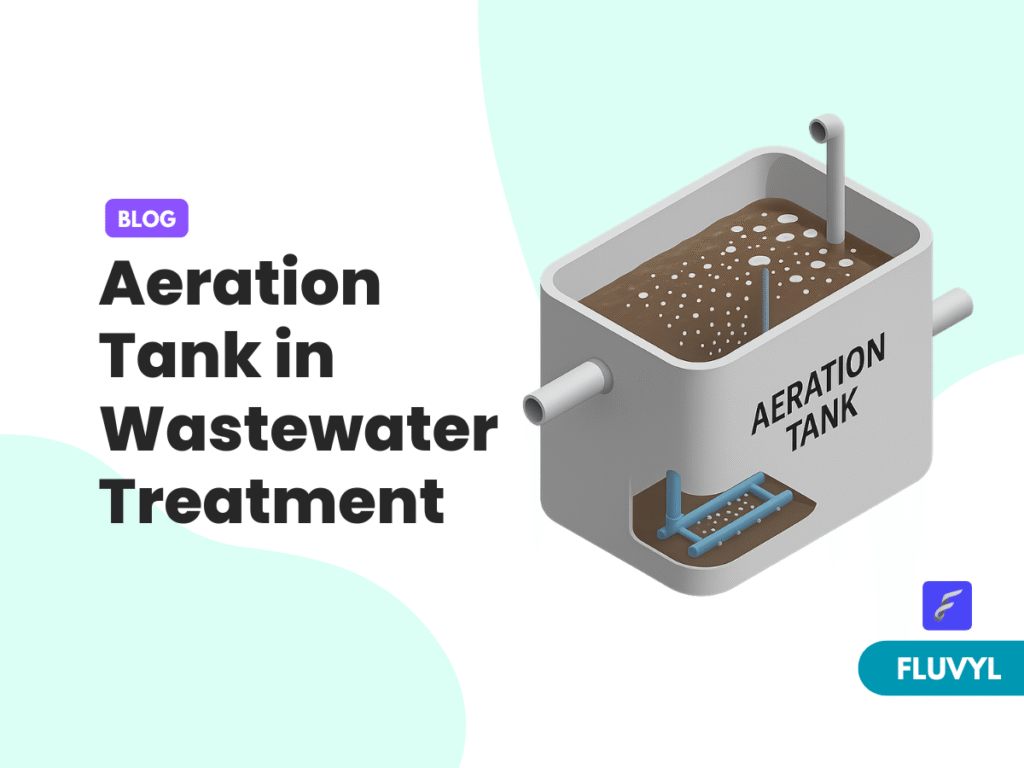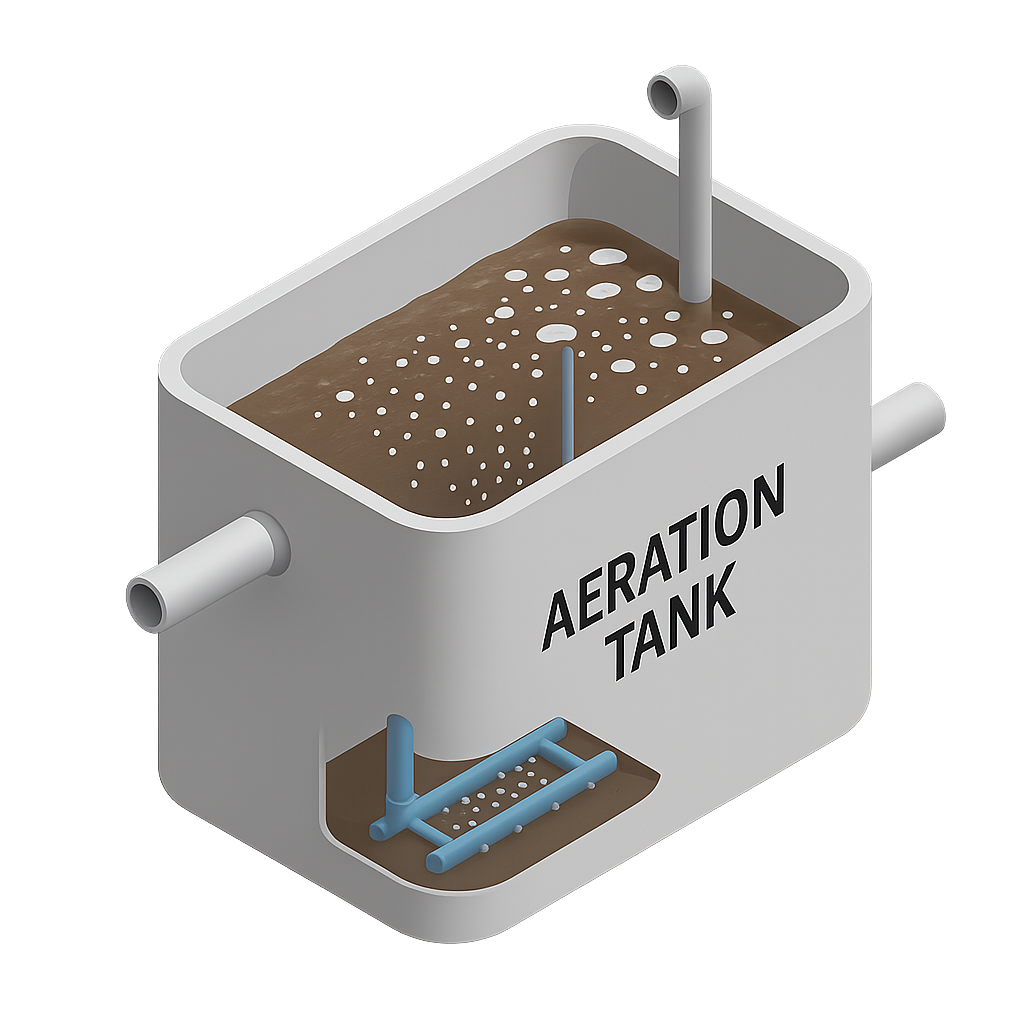Aeration Tank in Wastewater Treatment: A Complete Guide

By Fluvyl, updated Apr 26, 2025

Synopsis
- The aeration tank is a crucial component in secondary wastewater treatment, promoting aerobic biological degradation of organic matter.
- Common types include plug flow, complete mix, sequencing batch reactors, and extended aeration tanks, each with unique advantages.
- Key design parameters include hydraulic retention time, MLSS, F/M ratio, and dissolved oxygen levels, all influencing treatment efficiency.
- Challenges like high energy consumption and sludge bulking require regular maintenance and real-time monitoring for optimal performance.
- Innovations such as smart aeration controls, MABRs, and renewable energy integration are shaping the future of aeration tanks.
In the world of wastewater treatment, several processes work together to ensure that water is cleaned and safe to be released back into the environment. This tank is where biological treatment occurs, allowing microorganisms to digest organic matter in the wastewater. Understanding how the aeration tank works, its types, design considerations, and maintenance needs is crucial for anyone involved in wastewater management.
In this detailed blog post, we will explore everything about the aeration tank—from its function to its benefits—and provide insights into why it plays a vital role in modern sewage treatment plants.
What is an Aeration Tank?
An aeration tank is a section within a wastewater treatment facility where air typically oxygen is added to the sewage to support the development of aerobic bacteria. These microorganisms play a vital role in decomposing organic contaminants present in the wastewater. The aeration tank is part of the secondary treatment process, where most of the biological activity takes place. This tank ensures a continuous supply of oxygen, which is necessary for aerobic microorganisms to thrive and degrade organic matter efficiently.
Why is the Aeration Tank Important?
The aeration tank is essential because it facilitates the removal of organic pollutants from wastewater. Without this process, harmful substances would remain in the water, posing significant health and environmental risks. Here are the main reasons why the aeration tank is crucial:
- Promotes aerobic biological activity
- Removes Biochemical Oxygen Demand (BOD)
- Reduces Chemical Oxygen Demand (COD)
- Eliminates suspended solids
Enhances the efficiency of downstream treatment units
How Does an Aeration Tank Work?
In the aeration tank, wastewater from the primary treatment stage is mixed with a biological culture called activated sludge. This mixture is aerated using diffused or mechanical aerators. The oxygen supplied helps aerobic bacteria metabolize organic pollutants, converting them into carbon dioxide, water, and more microbial biomass.
The processed mixture then moves to the secondary clarifier, where the sludge separates and settles at the bottom. The clarified water is either released or directed to additional treatment stages. A part of the settled sludge is recirculated back to the aeration tank to sustain the population of microorganisms.

Types of Aeration Tanks
There are several configurations of aeration tanks based on the type of treatment and plant size. Each type serves a specific purpose and is selected based on the characteristics of the wastewater and space availability.
- Plug Flow Aeration Tank: Water flows in one direction from the inlet to the outlet, mimicking a pipeline. This type is ideal for treating high-strength industrial wastewater.
- Complete Mix Aeration Tank: The tank is fully mixed, ensuring uniform conditions throughout. This type is effective for municipal wastewater and fluctuating loads.
- Sequencing Batch Reactor (SBR): This is a time-sequenced process where filling, aeration, settling, and discharge occur in the same tank. It is suitable for small or medium-scale plants.
- Extended Aeration Tank: Designed for long retention times, this type ensures complete oxidation of organic material. It is widely used in decentralized systems.
Key Design Parameters of an Aeration Tank
Designing an aeration tank requires a clear understanding of hydraulic and biological parameters. The main goal is to optimize treatment performance while minimizing energy use and operational costs.
|
Parameter |
Typical Range |
|
Hydraulic Retention Time |
6 – 24 hours |
|
Mixed Liquor Suspended Solids (MLSS) |
2,000 – 5,000 mg/L |
|
Food/Microorganism (F/M) ratio |
0.2 – 0.6 |
|
Dissolved Oxygen (DO) |
1.5 – 3.0 mg/L |
|
Sludge Age |
5 – 15 days |
These parameters may vary depending on the wastewater characteristics and process objectives.
Aeration Methods Used in the Tank
Proper aeration is essential for maintaining dissolved oxygen levels and supporting microbial activity. The two main aeration methods used are:
- Diffused Air Aeration: Fine or coarse bubble diffusers are installed at the bottom of the tank. Compressed air is forced through these diffusers, producing bubbles that rise and mix the wastewater.
Pros:
- Energy efficient
- Uniform mixing
- Low maintenance
- Mechanical Aeration: Mechanical devices such as surface aerators or turbines agitate the water surface to introduce oxygen.
Pros:
- Easy to install
- High oxygen transfer rate
- Suitable for small-scale plants
Advantages of Using an Aeration Tank
The use of an aeration tank offers several advantages in the wastewater treatment process:
- Effective Organic Matter Removal: Aeration enhances the biological degradation of organic material, resulting in lower BOD and COD.
- Odor Control: Proper aeration reduces anaerobic conditions that produce foul odors.
- Scalability: Aeration tanks can be scaled up or down based on flow requirements.
- Energy Optimization: Modern aeration systems come with variable-speed drives and sensors to optimize energy use.
Stable Performance: Aeration tanks provide a stable environment for microbial growth, making the treatment process more reliable.
Challenges Faced in Aeration Tank Operation
Despite its advantages, operating an aeration tank comes with certain challenges:
- High Energy Consumption: Aeration systems consume a significant portion of the plant’s total energy.
- Foaming Issues: Excessive biological growth can lead to foaming, which affects the treatment process.
- Clogging of Diffusers: Fine bubble diffusers can get clogged due to sludge deposition or scaling.
- Sludge Bulking: Poor aeration can lead to sludge with poor settling characteristics, affecting clarification.
- Temperature Sensitivity: Biological activity in the tank is sensitive to temperature changes, impacting treatment efficiency.
Aeration Tank Maintenance and Monitoring
Proper maintenance and continuous monitoring of the aeration tank are vital for achieving optimal treatment performance. Key practices include:
- Regular Cleaning of Diffusers: Prevents clogging and maintains oxygen transfer efficiency.
- DO Monitoring: Ensures that the DO levels are within the required range.
- Sludge Sampling: Helps in understanding microbial health and sludge characteristics.
- Aerator Inspection: Mechanical aerators should be checked for wear and tear.
Energy Audit: Identifies opportunities for saving energy and reducing costs.
Innovations in Aeration Tank Design
-
Modern advancements in aeration tank design focus on improving efficiency, automation, and sustainability. Some notable innovations include:
- Smart Aeration Controls: These systems use real-time DO sensors and adjust air supply automatically.
- Membrane Aerated Biofilm Reactors (MABRs): Combine biofilm and membrane technologies to enhance oxygen transfer.
- Hybrid Systems: Combine aerobic and anoxic processes in the same tank to improve nitrogen removal.
- Compact Designs: Space-saving modular aeration tanks are being used in urban areas.
- Renewable Energy Integration: Some plants now integrate solar or biogas energy to power the aeration systems.
Applications of Aeration Tanks
Aeration tanks are not limited to municipal sewage treatment. They have a broad range of applications:
- Industrial Wastewater Treatment: Especially where high organic loads are present.
- Decentralized Treatment Systems: In residential societies, commercial complexes, and institutions.
- Aquaculture and Fish Farms: Maintain oxygen levels in water bodies.
- Greywater Recycling Systems: For treating and reusing domestic wastewater.
Leachate Treatment in Landfills: To break down biodegradable components in leachate.
Future of Aeration Tanks in Wastewater Management
As urbanization expands and environmental regulations become more stringent, the need for effective wastewater treatment is steadily growing. The aeration tank will continue to evolve with technologies that:
- Reduce energy consumption
- Improve microbial performance
- Enable real-time monitoring
- Support circular economy models through water reuse
- Ensure zero discharge practices in industries
The focus will be on integrating digital solutions like IoT and AI to make aeration tank systems more intelligent and responsive.
Conclusion
Aeration tank is a cornerstone of biological wastewater treatment, playing a pivotal role in ensuring that organic pollutants are broken down efficiently. From industrial applications to municipal sewage treatment, its ability to support aerobic microbial activity makes it an indispensable part of the process.
Designing and maintaining an efficient aeration tank requires a sound understanding of biological kinetics, oxygen transfer, and hydraulic considerations. As technology advances, so too will the effectiveness and efficiency of aeration systems.
Whether you’re a plant operator, environmental engineer, or someone curious about wastewater treatment, understanding how an aeration tank works is essential for appreciating the science behind clean water.
